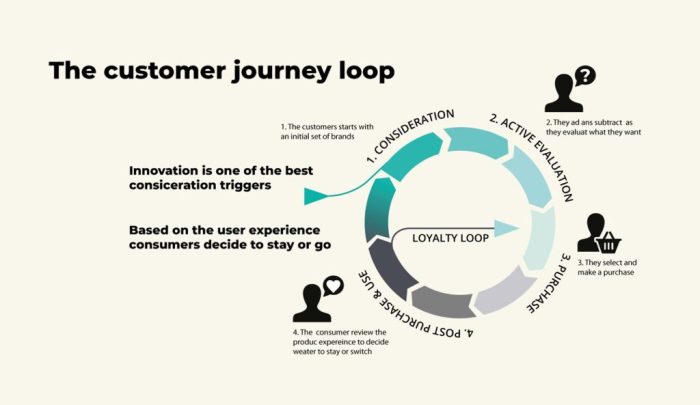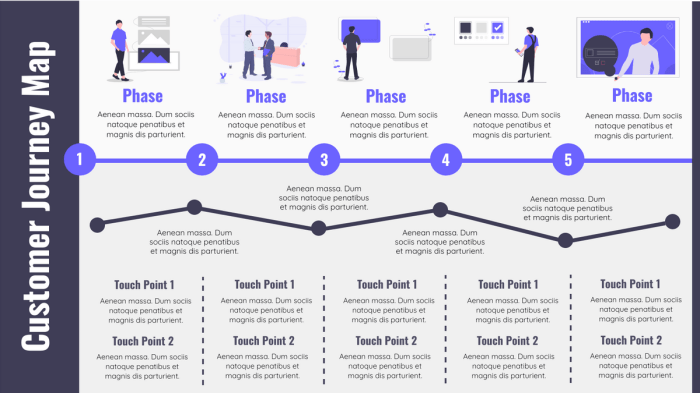Understanding the Customer Journey takes center stage in the business world, offering a roadmap to boost customer satisfaction and drive success. Get ready to dive into the key insights and strategies that can revolutionize your approach!
Importance of Understanding the Customer Journey
Understanding the customer journey is crucial for businesses as it allows them to gain valuable insights into the needs, preferences, and behaviors of their customers. By analyzing the different touchpoints and interactions a customer has with a business, companies can tailor their marketing strategies and improve the overall customer experience.
Benefits of Analyzing the Customer Journey
- Identifying pain points: By mapping out the customer journey, businesses can pinpoint areas where customers may encounter difficulties or frustrations. This allows companies to make necessary improvements to enhance the customer experience.
- Personalized marketing: Understanding the customer journey helps businesses create targeted and personalized marketing campaigns. By knowing where a customer is in their journey, companies can deliver relevant content and offers that resonate with their needs.
- Improved customer retention: Analyzing the customer journey can help businesses identify opportunities to engage with customers and build long-lasting relationships. By providing a seamless and consistent experience across all touchpoints, companies can increase customer loyalty and retention rates.
Enhanced Customer Satisfaction
- Anticipating customer needs: By understanding the customer journey, businesses can anticipate the needs of their customers and proactively address them. This proactive approach can lead to increased customer satisfaction and loyalty.
- Personalized support: Through analyzing the customer journey, businesses can tailor their customer support services to meet the specific needs of each customer. This personalized approach can result in higher customer satisfaction levels and positive word-of-mouth referrals.
- Continuous improvement: By continuously monitoring and evaluating the customer journey, businesses can identify areas for improvement and make necessary adjustments to enhance the overall customer experience. This commitment to improvement can result in higher customer satisfaction and loyalty in the long run.
Stages of the Customer Journey: Understanding The Customer Journey

In the customer journey, there are several key stages that a consumer goes through before making a purchase and beyond. Understanding these stages is crucial for businesses to tailor their strategies and meet customer needs effectively.
Awareness Stage
At the awareness stage, customers become aware of a brand, product, or service. This is the initial stage where businesses need to grab the attention of potential customers through marketing efforts such as social media, advertising, and content marketing.
Consideration Stage
During the consideration stage, customers start evaluating different options available to them. Businesses can provide detailed information, comparisons, and testimonials to help customers make informed decisions. Offering free trials or demos can also be beneficial at this stage.
Decision Stage
The decision stage is when customers are ready to make a purchase. Businesses can use tactics like discounts, limited-time offers, and personalized recommendations to encourage customers to convert. Providing excellent customer service and a smooth purchasing process are essential at this stage.
Retention Stage
After a customer makes a purchase, it’s crucial to focus on retaining them. Businesses can do this by offering loyalty programs, personalized communication, and excellent post-purchase support. Creating a positive customer experience can lead to repeat purchases and long-term relationships.
Advocacy Stage
In the advocacy stage, satisfied customers become advocates for the brand. They recommend the product or service to others through word-of-mouth, reviews, and social media. Businesses can nurture these relationships by rewarding loyal customers and encouraging them to share their positive experiences.
Mapping the Customer Journey

Mapping the customer journey is a crucial process that involves understanding the various touchpoints and interactions a customer has with a business from initial awareness to post-purchase engagement.
Tools and Techniques for Mapping the Customer Journey
- Customer Surveys: Gathering feedback directly from customers to understand their experiences and pain points.
- Analytics Tools: Utilizing data analytics to track customer behavior and interactions across different channels.
- Persona Development: Creating detailed customer personas to empathize with their needs and preferences.
- Journey Mapping Workshops: Collaborating with cross-functional teams to map out the customer journey collectively.
Step-by-Step Guide to Creating a Customer Journey Map
- Identify Customer Personas: Define the different types of customers who interact with your business.
- Map Touchpoints: Artikel all the potential touchpoints where customers may engage with your brand.
- Identify Pain Points: Determine the pain points customers may experience at each stage of the journey.
- Create a Timeline: Establish a timeline that represents the customer journey from start to finish.
- Analyze and Optimize: Analyze the customer journey map to identify areas for improvement and optimization.
Touchpoints in the Customer Journey
When we talk about touchpoints in the customer journey, we’re referring to every interaction a customer has with your brand throughout their buying process. These touchpoints can occur online or offline and play a crucial role in shaping the overall customer experience.
Various Touchpoints in the Customer Journey, Understanding the Customer Journey
- Social media platforms where customers discover your brand and engage with your content.
- Your website, where customers can learn more about your products and make purchases.
- Physical store locations where customers can interact with your products in person.
- Customer service interactions, whether through phone, email, or live chat.
- Product packaging and unboxing experiences that leave a lasting impression.
Significance of Optimizing Touchpoints
Optimizing touchpoints is essential for providing a seamless customer experience. By ensuring that each touchpoint is consistent, user-friendly, and aligned with your brand’s values, you can increase customer satisfaction and loyalty. Customers are more likely to complete their journey and make a purchase when their interactions with your brand are positive at every touchpoint.
